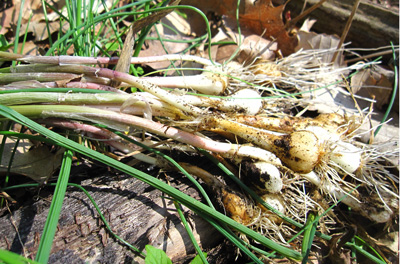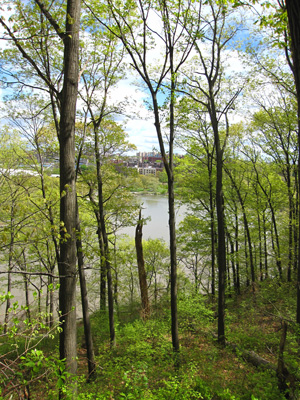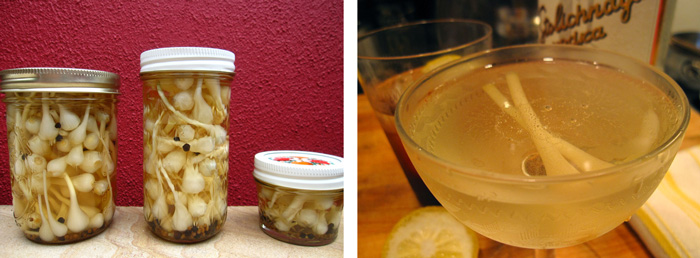Field Garlic, From Woods to Table
Food is in the eye of the beholder.
Manhattan and Brooklyn are unlikely sites for an outdoor pantry, for a Euell Gibbons-like existence of tapping trees for sap, nibbling redbud flowers in salad and steaming milkweed buds as a side dish. Yet New York City is the locus of my growing awareness of just how many things are good to eat beyond Mr. Lee’s vegetable stand on Atlantic Avenue, my usual source of all things fresh and green.
As a child in South Africa I nibbled brown berries in the Bloemfontein Botanic Garden, saw my father pick great brown-gilled mushrooms on the koppie near our house, and gathered pine rings on horseback in the forests of Tokai, in Cape Town, stuffing the orange fungi down the front of my buttoned white shirt. But my knowledge of edible plants on this continent extended only as far as their use in the gardens I designed on rooftops and behind brownstones - blueberries and juneberries. Fiddleheads and ramps, however, appearing at green markets in spring, started to give me a clue.

I signed up for a foraging tour of Brooklyn’s green mecca, Prospect Park. As we gathered around Steve Brill, our evangelical leader, whose foraging career took off famously after he was arrested for picking dandelions in Central Park, I wondered what we would see in the leaf-stripped November woods.
The first plant Steve found amongst the leaf and actual litter was a spindly bulb which he held aloft. Field garlic! he cried. Peevishly I demanded a botanical name. And that is how I met Allium vineale, a ubiquitous invader of gardens, fallow ground and woods. We all dived into the undergrowth to find our own. It was that first handful of unprepossessing bulbs that turned my head and made me fall in love with food growing in unusual places. That night the green leaves and white bulb were chopped into a stuffing for a roast chicken. It was redolent of mild garlic, a whiff of ramp, and something sweeter than either. I was hooked.
The following spring, on a walk in Inwood, which balances at the northeastern tip of the slim island of Manhattan, I discerned in the greening (and largely litter-free) woods fat clusters of field garlic, quite unlike the grass-thin offerings of the previous fall. Our walk screeched to a halt and my poison ivy-averse husband was pressed into helping me uproot the bulbs. Helpfully, I pointed out jewelweed, poison ivy’s antidote. The woods were quiet, and no rangers appeared to ticket our technically illegal activities. An occasional walker passed and glanced at us obliquely in the non-challenging way that New Yorkers have mastered in the face of borderline behaviour, careful not to engage in case we were certifiably crazy.
 A Latino family did stop, and discussed our actions amongst themselves, apparently came to a conclusion and left with a smiled blessing. Many immigrant communities seem more relaxed about searching for wild greens and foods than lifelong city dwellers, who view earthworms with alarm, consider plants that actually grow a nuisance, and who wake with a start if the night turns uncharacteristically silent.
A Latino family did stop, and discussed our actions amongst themselves, apparently came to a conclusion and left with a smiled blessing. Many immigrant communities seem more relaxed about searching for wild greens and foods than lifelong city dwellers, who view earthworms with alarm, consider plants that actually grow a nuisance, and who wake with a start if the night turns uncharacteristically silent.
Riding back to Brooklyn on the A Train, a 45-minute slog down the dark length of Manhattan’s bowels, our field garlic in its bag warmed and became penetratingly pungent. Fellow riders sniffed the air and themselves with discrete suspicion and doubt.
At home, the work began. Plunged in water, woodsy detritus floated to the top and was skimmed off and soil drifted to the bottom. I pulled an outer skin off each bulb, trimmed the roots, but kept the root head intact. I severed the fat crisp bulbs from their stems, discarded the tough middle stems and kept many of the long green leaves.
Half our haul was destined for pickling, a conversation piece for future Gibson cocktails, picnics, and long-term evidence of our efforts. We ate the rest in two sittings: roasted at high heat in a cast iron pan beneath tender baby ribs, and caramelized with slivers of pancetta and eaten with a poached egg whose running orange yolk made of breakfast a peerless pleasure. The greens we added to marinades and salads, which took on a deeper, wilder tone.
We have just returned from our second visit to those woods, and my new pickles, not ready for a few weeks yet, taunt me from the kitchen counter. Our slow-cooked Easter lamb was crowned with the sweet bulbs.
Pick your own now, into early summer, and again in fall. Pull out a clump, shake off the soil and separate and keep the fatter bulbs. You will be weeding, and feeding yourself handsomely.

Photo credits: Marie Viljoen

